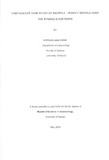| dc.description.abstract | The main objective of this study was to assess the performance of some existing
rainfall-runoff linear systems models and a conceptual model using data from the
Nyando catchment. In order to estimate the optimum parameters for the various models,
split samples of data were used; one sample for calibration and the other for verification.
The data used comprised daily areal average rainfall, daily average runoff and
daily average evaporation. Regression analysis method was used to estimate missing
rainfall and runoff data while seasonal mean 'method was used to estimate missing
evaporation records.
Homogeneity of the data was tested using the mass curve method. Results of
homogeneity test indicated that data from the catchment are generally homogeneous as
shown by the high R£ efficiency values.
The performance of each of three rainfall-runoff linear systems models, the
Simple Linear Model (SLM), the Linear Perturbation Model (LPM) and the Linearly
Varying Gain Factor Model (LVGFM), and a conceptual model called the Soil Moisture
Accounting and Routing (SMAR) model, was assessed using data from the Nyando
catchment. The linear systems models were applied in both non-parametric and also
under the constraint of the gamma function impulse responses. Optimum parameters
were obtained by the method of Ordinary Least Squares (OLS) and by Rosenbrock's
search technique for non-parametric and parametric modes respectively.
Results obtained in the simulation mode indicate that there is a good agreement
between the actual and estimated stream flow when the conceptual SMAR model is
used. For the SLM there is a marked difference between actual and estimated stream
flow especially in the case of low and high flow seasons, respectively. The performance
.of the other models falls somewhere in between the performance of these two models.
The conceptual SMAR model appears to be more superior to the linear systems
models with a higher R£ efficiency (71 %) than those of the linear systems models.
Among the linear systems models, the LVGFM performs best on the Nyando catchment
at R'" efficiency of about 69 %, followed by the LPM at R'" efficiency of 55 % and the SLM
at R'" efficiency of 47 % in this order.
From these results, the SMAR model may be considered the best model for the
Nyando catchment among all the models that were considered in this study. Among the
linear systems models considered, the LVGFM is the best model for the catchment
followed by the LPM and the SLM in this order. | en |

